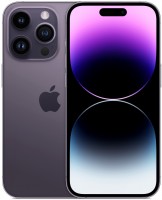Mobile Phones Apple series iPhone 15 Plus
iPhone 15 Plus
In addition to the regular iPhone 15, the wizards from Apple also presented the new iPhone 15 Plus smartphones, which are now positioned as an independent product line. Like last time, the difference between the regular model and the Plus version lies in the diagonal of the OLED screen (6.1 versus 6.7 inches) and the dimensions of the device itself. The design of the iPhone 15 has remained virtually unchanged since last time: a metal frame along the body, a ceramic back with a square camera block, and a cutout in the display. The only difference is that Apple has finally retired the old massive bang-shaped cutout, using instead the cuter and more modern Dynamic Island cutout, familiar to all fans of the brand from last year’s iPhone 14 Pro and iPhone 14 Pro Max.
 |
The heart of the iPhone 15 Plus family is the advanced A16 processor, which is approximately equal to the power of Apple's M2 laptop chip. That is, this is a truly powerful processor that will be extremely difficult to load with some typical smartphone tasks, given how well the M2 copes with professional applications on MacOS. Almost the entire front panel is occupied by a massive Super Retina display, created on the basis of a high-quality OLED matrix. The difference with the previous generation is an increase in peak brightness to 2000 nits, making HDR content on a smartphone look even more realistic.
Naturally, in the new generation Apple has allocated serious resources to improving the camera. The resolution of the main sensor has increased from 12 to 48 MP, 2x zoom brings you closer without loss of quality, the efficiency of night shooting algorithms has increased, and the front camera has acquired automatic focusing. Otherwise, this is a phablet familiar to all Apple fans with advanced communication capabilities (5G, Wi-Fi 6, satellite communications, dual NFC), proprietary Face ID protection system, fast and wireless charging, excellent speakers and the auto-accident detection system introduced in the last generation. called Crash Detection.
















